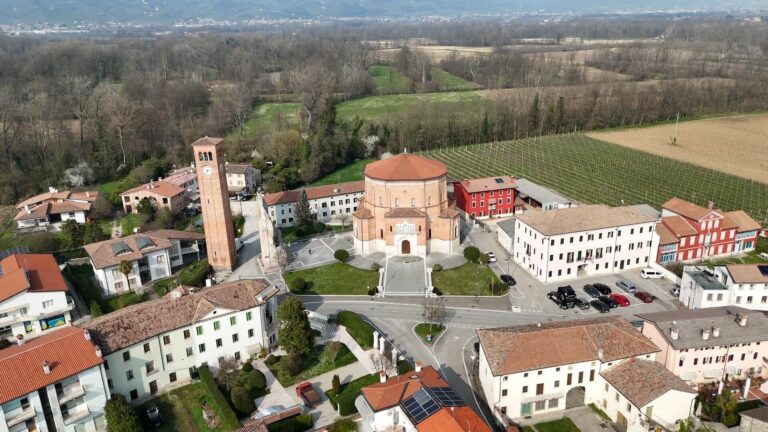ARTISTS’ ROADS
LE VIE DEGLI ARTISTI
watch the videos at the bottom of the page!
MORIAGO DELLA BATTAGLIA
Time Passes, Art Remains
Twelve figures, each over three metres tall, stand upon roughly hewn stones or squared marble blocks.
Their feet are firmly planted on the ground, barefoot or in simple footwear.
Their faces are expressive, speaking faces. They converse, they question us.
Their gestures are eloquent.
Tunics, robes, cloaks.
Red, white, green, blue, ochre, brown. Never overly bright, each tone subdued, blended into the others.
These are the Twelve Apostles of the Pentecost, painted in the dome of the parish church of Moriago della Battaglia.
Behind each figure is a slab of marble, painted to evoke the beauty and solidity of the Creation.
But what binds them together is a high band, a fishing net, and woven mats made from reeds that grow in the Palù wetlands of this land.
Everyday objects, hand-crafted, used by the fishermen of Lake Tiberias and of the Piave alike.
With touches of white, water droplets are rendered luminous, suspended, ready to fall.
The expressive force of their bodies, and above all their faces, makes them feel real. They truly are fishermen of Galilee.
But this fidelity to the Gospel narrative, so moving today, caused scandal in 1925.
Because those faces belonged to the mayor of the time, the town chemist, some local dignitaries, and even a few citizens of Moriago whose reputation was far from spotless.
They could not possibly represent the Apostles.
It became a controversy that made Moriago famous. It involved the bishop, the diocesan curia of Vittorio Veneto, even the Pontifical Commission for Sacred Art, as well as the national and international press.
But over what once caused scandal, time has drawn its veil, thanks to the painter’s resolve never to alter those faces, now no longer recognisable.
What remains today is the gift of a truly unique work of art.
Its creator was Guido Cadorin, who collaborated here with Astolfo de Maria.
The work was completed between 1924 and 1925.
It was the fitting conclusion to an architectural project of bold vision, in a land impoverished and devastated by the Great War.
Shells fired by the Italian artillery beyond the Piave had destroyed the previous church, remembered still in the truncated form of the bell tower.
The architect Alberto Alpago Novello designed a brick building in a polygonal plan, a solid casket with a central layout, recalling both early Christian and Byzantine tradition, and the age of Saint Leonard of Limoges, to whom the church is dedicated.
But let us look up to the sky.
For that wide portion of the dome, Cadorin worked with Giovanni Zanzotto, father of the poet Andrea.
The blue is intense, crossed by sixteen tongues of fire, each pointing to an Apostle, alongside four chalices symbolising the Evangelists.
The inscription, drawn from the Acts of the Apostles, describes the scene of the Pentecost and is placed one-third of the way up.
The reference to the Pentecost dome of St. Mark’s Basilica is explicit, as openly acknowledged by the artist.
But here in Moriago, the tongues of fire are more vivid.
And they seem to recall the bombs that, for a year, streaked across the dark night skies above Moriago.
PHOTO 360 Move the mouse over the image
MORE EXPERIENCES!
Il Novecento, quello bello!
- Fra’ Claudio Granzotto, arcipretale di Santa Lucia di Piave.
- Carlo Donati e Giuseppe Modolo, arcipretale di Sernaglia.
- Pino Casarini, Conegliano, parrocchiale della Madonna di Lourdes.
MULTIMEDIAL MAP: “ARTISTS’ ROADS – LE VIE DEGLI ARTISTI- EN”!

